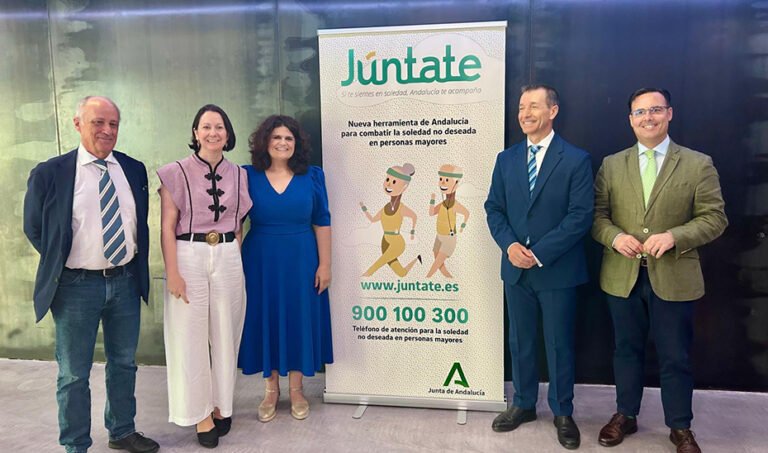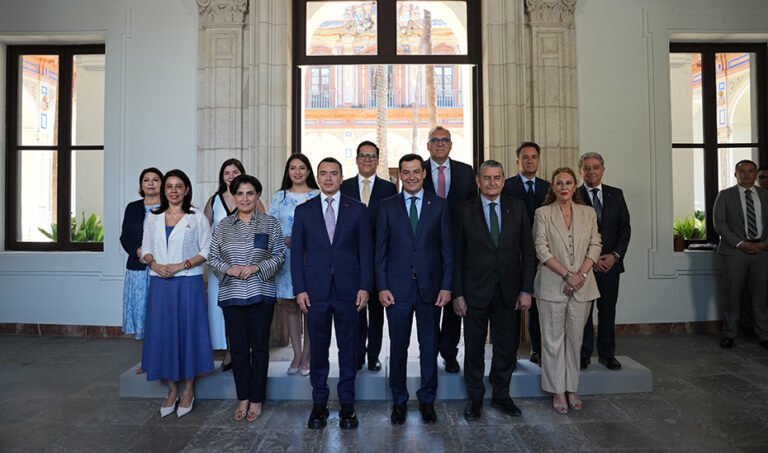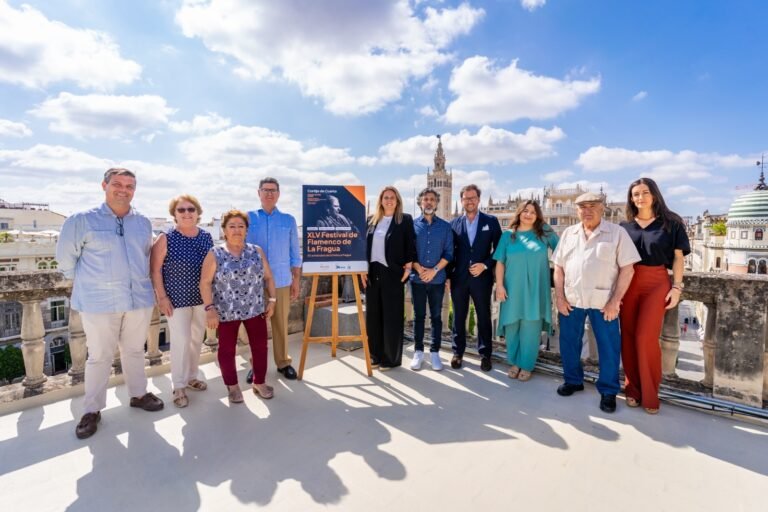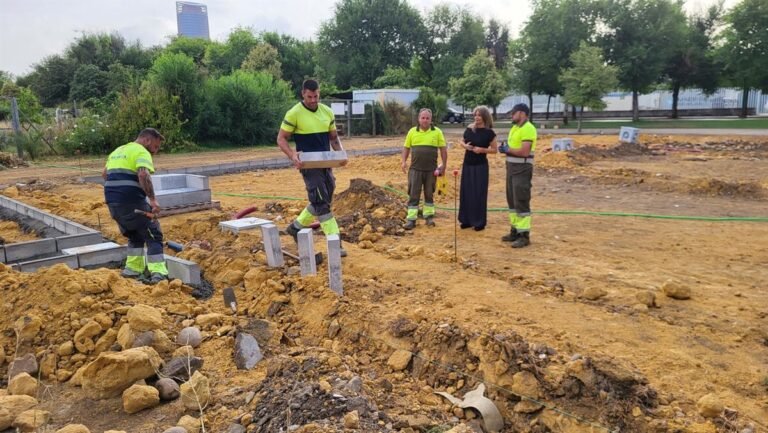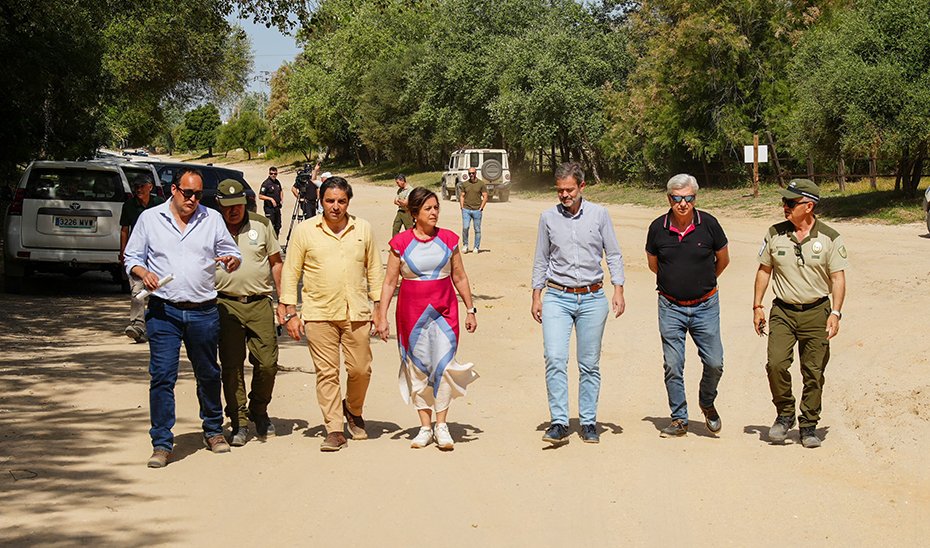
The Sustainabilty and Environment Councilor of the Andalusian Government, Catalina García, has visited the actions carried out on livestock routes and forest paths in the province of Huelva as part of the Plan Romero 2025, with a total investment of 420,344 euros. The visit took place in the surroundings of the Ajolí Bridge, one of the main access points to the village of El Rocío, recently repaired after the damage caused by heavy rains in March.
During the tour, Catalina García emphasized that «these actions have been essential to ensure the safe passage of the brotherhoods, as well as emergency vehicles and medical services». In this regard, she highlighted that «the Andalusian Government has acted diligently and proactively to ensure that the roads are in optimal conditions before the start of the pilgrimage.»
Specifically, the interventions in Huelva have included work in several municipalities and high-traffic sections, such as the Vereda de Abajo (Ayamonte), the Carril de los Coches (Niebla), the Colada de Sevilla (San Juan del Puerto), the Cañada Real de Ayamonte a Sevilla (Gibraleón), the Cañada Real de Sevilla (Huelva), and the Vereda del Camino del Río (Bonares). These works have involved grading, scarifying, and compacting the pavement, opening ditches, vegetation control, and the addition of macadam (stone pavement) and riprap.
The councilor emphasized that «these are sections heavily used by the brotherhoods on their way to the village, and their maintenance is crucial both for safety and for the preservation of the natural environment they pass through.» The total investment for these actions has been 102,692.02 euros.
Furthermore, among the completed works, the repair of the access to the Ajolí Bridge stands out, within the Vereda de la Rocina, which was severely affected by the storms. There has also been intervention in the well-known Barrio de las Gallinas, in the village itself, another key point for pilgrim traffic. Both interventions have entailed an investment of 11,000 euros.
Additionally, through the REDVÍA program, 141,402.74 euros have been allocated to paths located within the protected natural area of Doñana, and another 30,000 euros to areas such as the forest path of Cartaya and various sections of the public mountain ‘Ordenados de Moguer’. Likewise, the councilor has reported on the work carried out in the Coto del Rey area, amounting to 45,114.28 euros, involving foot marking, tree felling, clearing, debarking, and clearing, among other actions. This is complemented by a budget allocation of 90,135 euros for cleaning equipment, compactors, tractors, trailers, tanks, and work crews.
All these actions complete the interventions, with a budget of 420,344 euros. «Thanks to this investment, we have been able to act both on direct access areas and on strategic forest conservation sections, resulting in a comprehensive improvement of the pilgrimage routes in the province,» García stated.
The councilor was accompanied by the mayor of Hinojos, Joaquina del Valle Ortega; the mayor of Almonte, Francisco Bella; the territorial delegate of Sustainability and Environment in the province of Huelva, Pedro Yórquez, as well as Environmental Agents and technicians from the Territorial Delegation, among other attendees.
Coordination and annual planning
The Plan Romero is deployed each year to address the specific needs of the El Rocío pilgrimage. Its scope is regional, but it is developed in coordination with the territorial delegations of Cádiz, Seville, and Huelva. In the case of Huelva, deficiencies in sections are analyzed on-site each year, at the proposal of the brotherhoods and involved municipalities.
The Sustainability and Environment Councilor indicated that «these actions have been possible thanks to close institutional coordination, involving both the technicians of the Territorial Delegation and local authorities and representatives of the brotherhoods.» Catalina García highlighted the role of the Plan Romero as «a demonstration of the commitment of the Andalusian Government to our traditions, but also to the protection of the natural environment and the enhancement of our rural heritage.»
Other actions within the Plan Romero 2025
These improvements add to those already announced in the province of Seville, where 391,905 euros have been allocated to similar interventions in key locations such as the Vado del Quema, the Cañada Real de la Isla, or the public mountains of Aznalcázar, among others.
In Seville, work has also focused on roads affected by the heavy rains in March. The councilor recently visited these areas, where she observed tasks such as repairing bumps, clearing, pruning, silvicultural conditioning, and revegetation work in resting and overnight areas for the brotherhoods. In the province of Cádiz, 30,752 euros have been allocated for the adaptation of livestock routes in the municipality of Rota, linked to the Plan Romero 2025.
She also pointed out that «the Andalusian Government has invested over 67.7 million euros in the repair and maintenance of 1,513 kilometers of livestock routes throughout the region since the beginning of the term, reflecting a firm commitment to improving these ecological and traditional corridors.» Regarding the province of Huelva, she noted that the investment has been 8.97 million euros aimed at improving and conditioning over 298 kilometers of livestock routes and forest paths.
A commitment to sustainability and tradition
Catalina García highlighted that «all these works have been carried out with environmental sustainability criteria, always seeking a balance between ecosystem protection and the conservation of our popular customs.» In this regard, she argued that «the maintenance of the pilgrimage routes is an operational matter, as well as a cultural identity and respect for the territory.»
The councilor concluded her speech by emphasizing that «the safety of people and the environment has been the priority in each and every decision made within the Plan Romero,» and thanked the municipalities, brotherhoods, and technical teams of the Government for their involvement in the planning and execution of the works.

